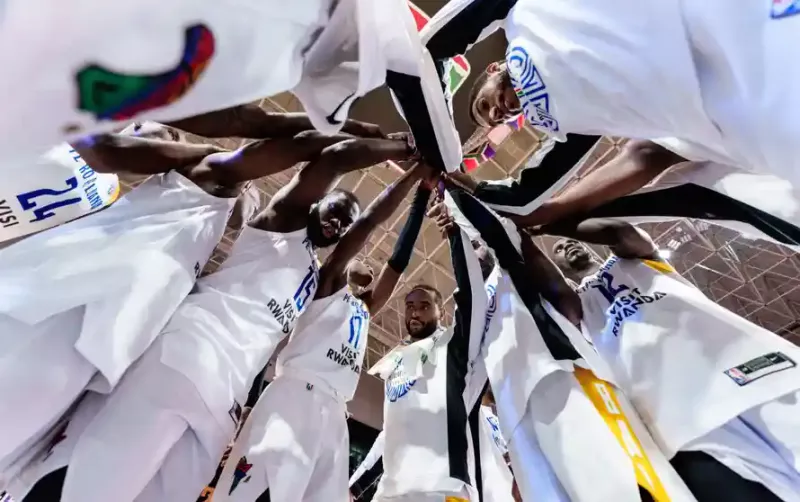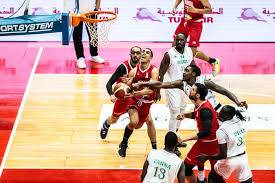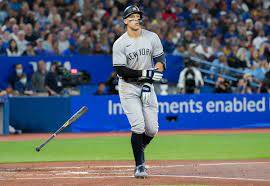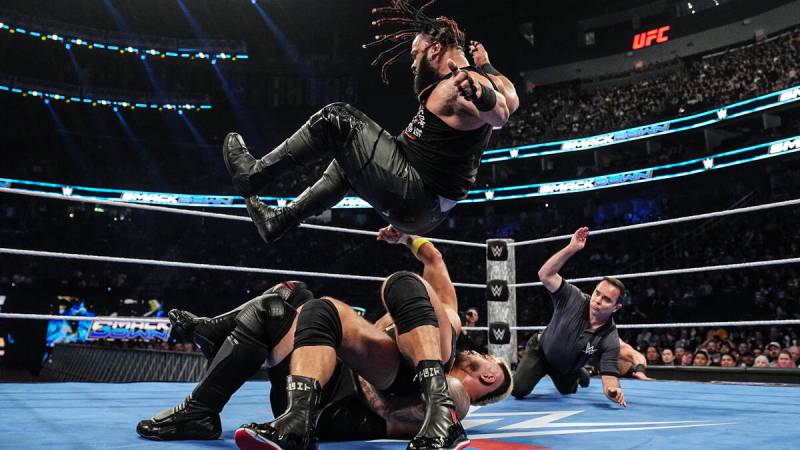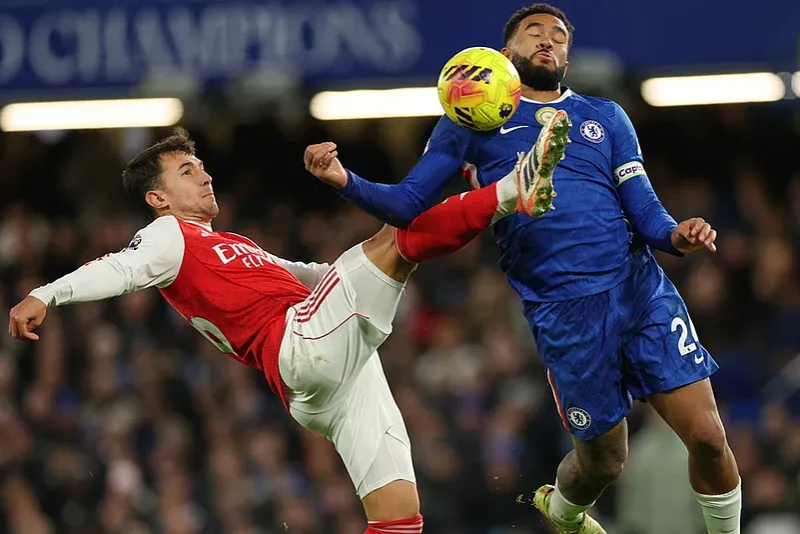The Basketball Africa League, a joint project between the NBA and Fiba, hopes to tap into a market with a huge, tech-savvy and youthful population. Will it take hold?
On a March evening at New York’s John F Kennedy International Airport, an agent beckoned me over to the check-in counter and asked for my passport. As he thumbed through its pages, he paused on the page with a red visa stamp and an imprint of a baobab tree.
“What’s your reason for traveling to Senegal?” he asked in a tone simultaneously neutral and stern.
“I’m attending a basketball tournament there,” I told him.
“Oh, some people flew from here only a few days ago carrying jerseys,” he said, perking up in his chair. He told me he was from Senegal himself. “Basketball is coming up in Senegal,” he said proudly.
I thought of the agent as I watched the the opening ceremony of the second season of the Basketball Africa League (BAL) at the 15,000-capacity Dakar Arena – a spectacle of color, music and dancing against a backdrop of raucously cheering fans. Videos would later circulate on social media of Dikembe Mutombo – the Congolese star who played nearly two decades in the NBA and who is now an investor in its nascent African project – dancing with fans. All around the arena, people sang and waved the green, yellow and red flag of Senegal.
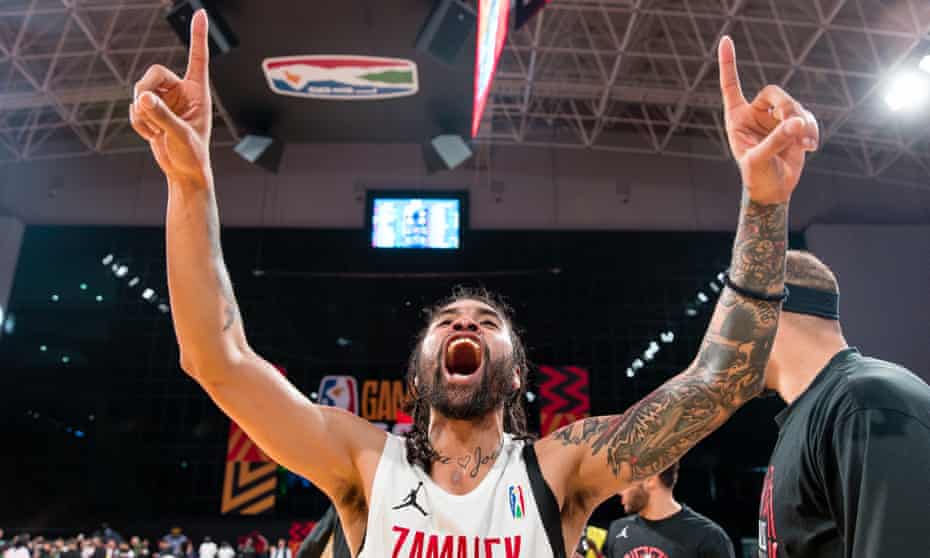
Michael McKinney of the Zamalek celebrates after a game against the Clube Atlético Petroleos de Luanda in April at Hassan Mostafa Indoor Sports Complex. Photograph: Julien Bacot/BAL/NBAE/Getty Images
“In Africa, when something special is happening in a family, we need to celebrate,” Mutombo would tell me later in a phone interview, laughing. “It’s always been my dream since I got into the league: I want to see the next Dikembe Mutombo playing in the NBA. I want to see the NBA on my continent. The continent of Africa was a place full of treasure and I was happy to see that taking place.”
Mutombo’s joy reminded me of something similar that the journalist Syra Sylla told me weeks earlier. A French-Senegalese basketball writer, who played basketball growing up in France, she was “obsessed” with NBA basketball, particularly the Los Angeles Lakers.
“We all dreamt of Europe and the United States, but now we have this league,” she said. “It’s like the NBA has come to us. We can see and admire players in Africa, and it’s great to have those role models who are good.”
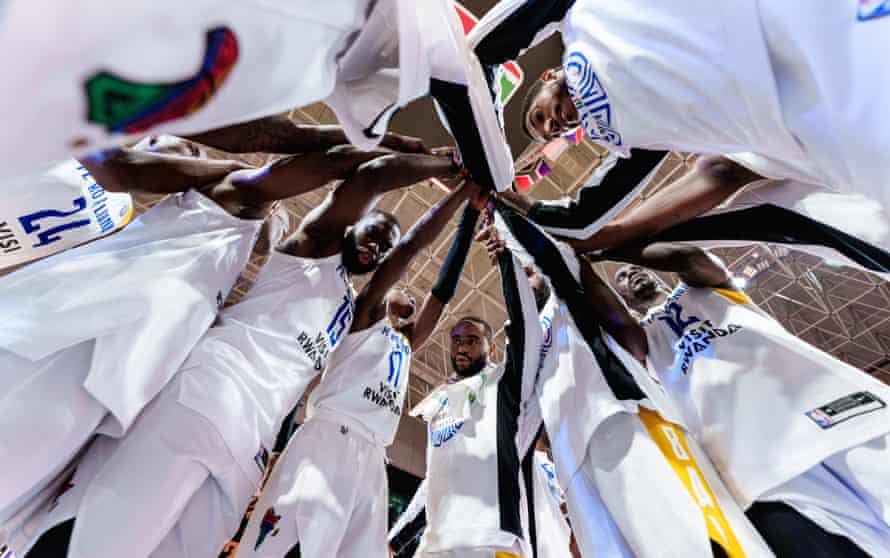
Clube Atlético Petroleos de Luanda huddles after an April game against the BC Espoir Fukash at the Hassan Mostafa Indoor Sports Complex. Photograph: Armand Lenoir/BAL/NBAE/Getty Images
BAL is a joint project between the NBA and Fiba, basketball’s world governing body, that hopes to tap into a market with a huge, tech-savvy and youthful population, while also giving African hoopers the platform to showcase their talent on the continent and a potential path to one day star in the US. Those who have shown their support for the league include Mutumbo, Barack Obama, NBA commissioner Adam Silver and some of Africa’s top businessmen.
“There is now a clear pathway, back from grassroots to elite, where a young boy, no matter where they are from, can dream about playing the sport, have access to play the sport, have the development stages they can go through and be a success,” Amadou Gallo Fall, a former Senegalese player who is now president of BAL, told me in an interview.
“The Basketball Africa League is the culmination of really many decades of work across the continent to grow the sport, to shine a spotlight on basketball,” he said.
Playing host to the Sahara Conference for this second season of the BAL came at a celebratory moment for Senegalese sports. Tens of thousands of fans had burst onto the streets of the capital, Dakar, a few weeks earlier to celebrate their country’s football team winning its first Africa Cup of Nations.
Evidence of this pride was for all to see as I landed at Dakar’s Blaise Diagne International Airport. After making my way through customs, I was greeted by a blown-up image of stars from the team on an ad from the French telecom giant Orange. Stepping out into the hot Senegalese sun, I was met by another gargantuan face: this one belonging to Sadio Mane, the country’s football superstar, the country’s football superstar, who played for Liverpool in the English Premier League until a recent move to German giants Bayern Munich.
I asked my shuttle driver, Aboubakar, what he thinks about basketball. “It’s cool,” he said. “Football is No 1.” But basketball is cool, he repeated.
En route to the hotel, Senegalese flags were everywhere, yet more reminders of the pride its recent soccer victory brought to the 17m people of this West African nation. Mosques abound. West African Islam is at the core of people’s identity here. But as important as tradition is, it was hard to miss another salient fact of Senegalese demography: The population is strikingly young – with a median age of just over 18.
The challenge for the BAL is that a lot of those young Africans want to emulate emulate Senegal’s Africa Cup of Nation winners, rather than the Golden State Warriors or Boston Celtics.
Soccer has long pulled any African kid with a hint of speed and agility into its grasp. And it’s also cheap: to play soccer, all a child has to do is roll up some corn husks or rags and tie them tightly into a ball with a few grocery bags scooped from the trash.
“We make a ball and wrap plastic around it and pass it to each other,” Bismack Biyombo, a 10-year NBA veteran from the Democratic Republic of Congo who played for the Phoenix Suns last season, told me. Basketball, on the other hand, requires at the very least a concrete court, if not a wooden floor, and two suspended hoops. Not to mention a ball that can bounce.
The NBA and BAL don’t think they can overtake soccer, but they hope they can change the balance a little. A half-hour drive from the Palm Beach is where you’ll find NBA Academy Africa. Red-roofed buildings with cream-colored walls are housed within a campus encircled by soaring pine trees. In 2017, the NBA launched the academy with the goal of providing NBA-level training for talented young prospects across the continent. A year later, the academy brought with it the construction of two indoor basketball courts that, from the outside, look like they reside within a greenhouse.

Ulrich Kamka Chomche of the NBA Academy Africa celebrates a three-pointer against the Rwanda U23 National Team at the Kigali Arena. Photograph: Armand Lenoir/BAL/NBAE/Getty Images
Soon, young players from across Africa began trickling onto the court, and a chorus of basketballs thudded around the gym. The court was the theater of dreams for these kids, the promise of what was to come. On the other side of the gym was the famous NBA logo. The message for the kids in that gym was unmistakable – you could join African stars like Joel Embiid and Pascal Siakam and be a part of the league’s future.
Ulrich Kamka Chomche from Cameroon stood out. He has been at the academy for three years. The 16-year-old is already 6ft 11in but has the agility of a guard. He easily drove by a coach and threw down a ferocious dunk.
Chomche told me later after practice that the first time he watched an NBA game on television was when he arrived at the academy. He began playing when he was about nine years old. He would compete on his village’s concrete courts, where he’d scrape his knees and hurt his back, he said. He was grateful for the chance to play on hardwood.
Basketball is almost meditative to Chomche. When he plays, he enters his own world. “I’m doing the thing that I love the most,” he said. “I want to be the best player I can be. That’s why I practice hard.”
He finds inspiration in the success of his countryman, Embiid, who finished second in NBA MVP voting this year, was the league’s scoring champion and is considered one of the finest players in the world.
“I can make it too, like him. So, If I work hard, I am going to make it like him,” he said. “It’s not impossible.”
NBA executives know that recruitment of the likes of Chomche and other young talent ever earlier in their basketball development is a crucial part of the strategy for growing the game on the continent.
Kim Bohuny, a longtime head of NBA’s international basketball operations, says that compared to the US, where almost everyone touches a basketball growing up, African players have tended to start later.
“They are not as instinctive because they are starting later,” she told me. “They have specific talents but not all-around talent, offensively or defensively. You might be a great shot-blocker or instinctive rebounder.”
In Saly, Chomche showed that he is more than just a big man who just rebounded and blocked shots. He was an example of the modern talent that can emerge out of the continent.
The young Cameroonian was one of 12 NBA Academy prospects who played for teams competing in the 2022 BAL tournament. For the league, the move created another pathway for talented young Africans to gain elite, competitive experience. Chomche was a key contributor for his side, Cameroon’s FAP, during their journey to the playoffs. Another academy product, guard Serigne Saliou Mbaye, an 18-year-old from Senegal, helped Guinean champions SLAC make it to Kigali for the knockout phase of the tournament.
We’re adding value to human capital, on the African continent, by the African continent, for the African continent
NBA Africa CEO Victor Williams
The young men hoped to emulate the success of Egyptian Mohab Yasser, whose starring role in BAL last season with the eventual champions Zamalek during the league’s inaugural season, helped him secure a path to play college basketball in the United States.
Back in the day, NBA scouts looked for big African players who could grab rebounds and not much else. The NBA wants to challenge that stereotype, says Roland Houston, the Academy’s technical director, as he sat courtside and directed the training in the gym.
“We focus in on having a complete basketball player,” he said.
He pointed to a 15-year-old from South Sudan who was executing a post-move drill on the court. “You see how he has footwork, how he’s moving with the feet? And that’s very important. You’ve got to have good footwork,” Houston insisted. “We also want big guys to be able to dribble the ball and shoot the ball, not just rebound and block shots.”
For Houston and the NBA in Africa, the Academy is part of the league’s mission to change the culture and structure of the evolution of talent on the continent.
“It’s just not seven-footers and we have plenty, plenty of them,” Houston said. “But we have 6ft 5in, 6ft 4in guards who are elite-level players, too. They have the opportunity to go from junior NBA to academies.”
“And now we have the BAL, which is phenomenal,” Houston said.
For 10 days in March, the Dakar Arena was the focal point of the BAL, playing host to the elimination rounds for the Sahara Conference, which included teams from Senegal, Tunisia, Morocco, Rwanda, Mozambique and Guinea. Four of those six teams would go on to the playoffs, scheduled to take place in Kigali, Rwanda, in May.
In games that were both physical and frenetic, Rwanda Energy Group came out on top, followed by the Tunisian powerhouse and last year’s finalist, US Monastir. Moroccan outfit AS Sale and the Guineans of SLAC took the remaining playoff spots.
The basketball was terrific and provided several highlights that went viral on social media. There were ferocious dunks, closely contested games and game-winning buzzer-beaters. But none of that, it seemed, was enough to keep people in the stands.
When the home team, DUC, played, 2,000 rabid fans – many of whom were students from the Cheikh Anta Diop University where the team is housed – showed up and made noise.
When DUC wasn’t playing, however, things were a lot quieter. When Jean Jacques Nshobozwabyosenumukiza hit “the biggest shot” of his career to win the game for Rwanda’s REG against SLAC, few fans were there to see it happen.
I asked Mutombo about the lack of fans when the local team wasn’t on the floor.
He said the timing of the games may have hurt attendance and acknowledged that there is work to do. “We are new on the continent,” he said. “It’s a new experience for the NBA as well. But we learned a lot.”
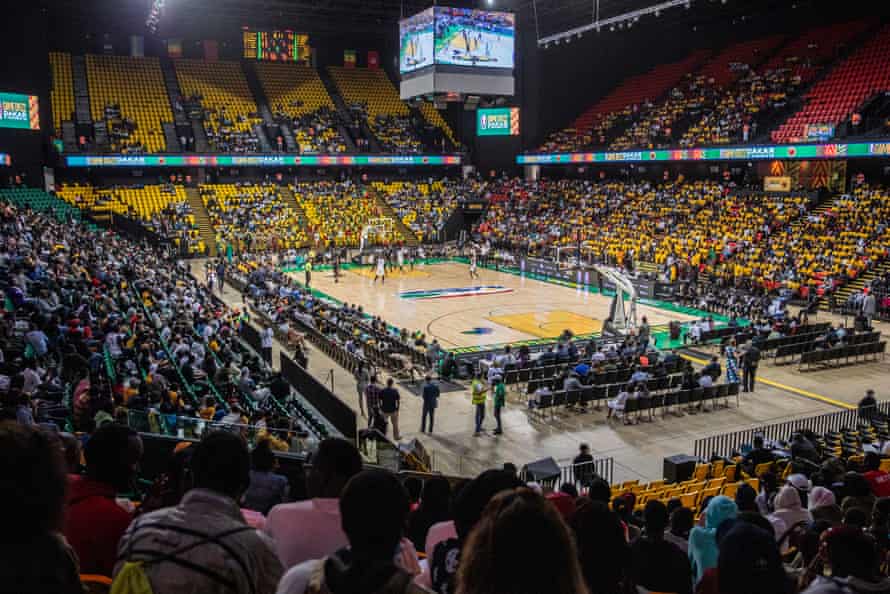
An overall photo of the Dakar Arena during the game between the Dakar Université Club and the Seydou Legacy Athlétique Club in March. Photograph: Pape Emir/NBAE/Getty Images
He expected there to be more fans at games in Egypt, where the season moved to next, when the games tipped-off after working hours. But even in Cairo, where there was rabid support for the defending champions Zamalek, few fans showed up for the other games. Things did change during the playoffs, more fans packed the BK Arena in Kigali to watch Africa’s top talents compete for the championship.
In the final, Tunisian champions US Monastir outdueled Angola’s Petro de Luanda to win the 2022 BAL title avenging the loss they suffered in last season’s title game.
In Senegal, the legendary Tunisian Radhouane Slimane, who at 41 was still playing at an elite level and went on to help his AS Monastir team win the BAL title later in Kigali, blamed the lack of fans on local media not doing enough to cover the league.
“The media in the country has a big responsibility. Maybe a lot of fans here don’t know that there is BAL playing now in this arena. They have to work on it,” he said in an interview. “In Tunisia, a big event like this, you are going to have the arena full. No empty spaces. Because the people there, love basketball.”
Yet even with half-empty arenas in Dakar, the “product”, as NBA Africa executives refer to the BAL experience, was a high-level production that appeared to be well shared beyond the basketball court. Before each game day, a live Twitter Spaces show provided pre-game analysis. During games, highlights were shared on social media platforms as broadcasters beamed the action across the world.
All this, in theory, game after game, tournament after tournament, should make stars of the players and personalities beyond the court. For the league – again, in theory – it should steadily build an audience of engaged fans. For the audience, the multimedia echo should project an image of a professional and, hopefully, thrill-a-minute league. And with any luck, say BAL’s true believers, the two will feed upon each other.
“More affordable technology has made the continent a much more relevant market for the consumption of content and products,” NBA Africa CEO Victor Williams said. “We’re starting from a base where basketball is already the second sport or the top-two sport in many countries around the continent, and there’s a hunger on the continent to explore it.”
Coach Liz Mills, who was the only female head coach at this year’s BAL and led her Moroccan side AS Salé to the playoffs as the third seed from the Sahara Conference, said the new league has given African basketballers – from players to coaches – their moment to shine.
“They’ve given time, resources, and dedicated their lives to playing basketball in Africa,” Mills told me in a Zoom interview from her home in Rabat. “It’s great for them to be rewarded for all the sacrifices they’ve made. And the BAL is a perfect league for them. Because they are made to feel like professionals. They are made to feel like they are the stars, right? And that’s what I really appreciated about the league.”
On the morning of my last day in Senegal, I sat down with John Manyo-Plange, BAL’s vice president and head of strategy and operations. Manyo, a stocky man with a clean-shaven head and a gray-speckled beard and is originally from Ghana, was deliberate in his speech. He presented a vision of a decade-long strategy of growing the BAL that is rooted in the belief that the “cool factor” of basketball is a perfect match for Africa’s youthful population.
I asked him what was at stake for the NBA in its expansion into Africa. “Everything,” he said. “All of this is, is part and parcel of the NBA’s global strategy. So, to answer that question, everything’s on the table, everything’s at stake.”
He declined to give specifics on how much the NBA was investing into the new league and only said it is in the “multiple, multiple, millions of dollars”.
Manyo said the NBA was paying teams to cover their costs of operations during the tournament, including funds for them to attract and pay top talent – each team is also allowed a certain number of foreign players from Europe and North America – who will take part in the league.
“In addition to covering all the expenses, there’s actually team payments that we make,” said Manyo. “And that’s really meant for them to go out and get higher level talent to augment whatever the existing talent there is.”
The NBA was betting that the cache of being part of an NBA-run league will spur countries and teams to invest in their teams and in basketball infrastructure overall in order to get a shot at competing in the BAL.
“We are creating an aspirational product that everybody then wants to be in,” Manyo said. “To do that, they have to invest, they have to play, they have to sweat, and that lifts everything up.”
The vision that has led to the projected $1bn valuation of the NBA’s Africa business, according to Williams, is that, as the BAL grows, and the quality of play improves, so too will interest from television broadcasters, advertisers and fans – all of whom will drive revenue growth.
“They’ll be attracted to African heroes, and there will be fantastic stories that they can relate to that come out of the BAL,” Williams said. “All of those will help drive the building of the brand as well as the commercial propositions associated with the league.”
In Senegal, Manyo painted a vision of the BAL as a platform for Africans to realize their hoop dreams on the continent without having to go search for it elsewhere. “We’re adding value to human capital, on the African continent, by the African continent, for the African continent,” he said. “And we’re showcasing it in such a way that it’s appreciated and consumed globally.”
The commitment the NBA was making to African basketball and BAL was “permanent”, Manyo said. “We are here,” he added. “We’re not going anywhere.”
By Omar Mohammed
